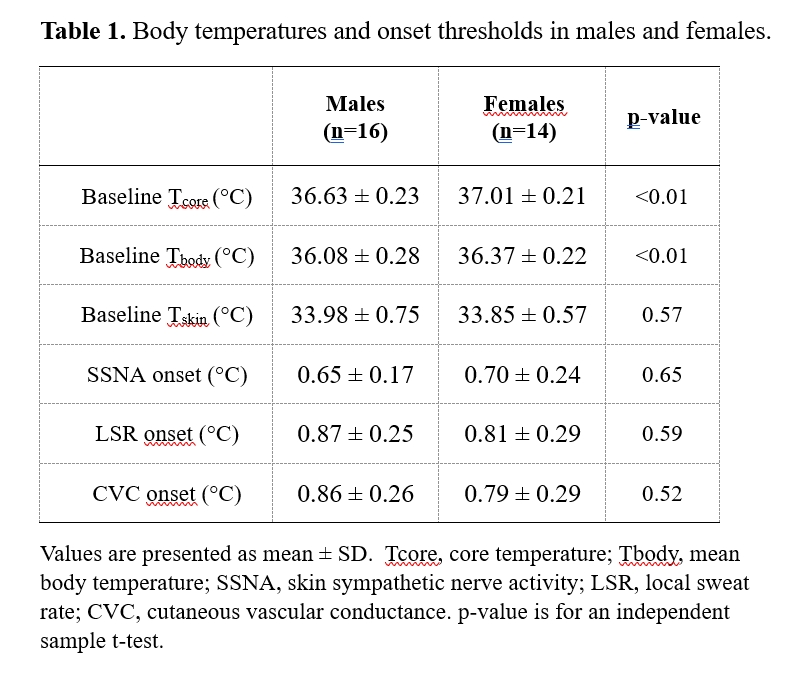Introduction: Understanding how thermoregulatory responses differ between males and females could contribute to a better understanding of sex-related differences in heat vulnerability (1). Previous studies found that maximal sweating capacity is greater in males, in part due to greater cholinergic sensitivity of the eccrine sweat glands (2). It remains unknown if the neural control of body temperature differs between males and females during heat stress.
Objective & hypothesis: This study aims to determine the effect of biological sex on the neural control of body temperature during passive heat stress. We hypothesized that the onset threshold for increases in skin sympathetic nerve activity (SSNA), local sweat rate (LSR), and cutaneous vascular conductance (CVC) are equivalent between males and females.
Methods: Sixteen healthy males (21-39 yrs) and fourteen healthy females (21-36 yrs, low reproductive hormone phase) were exposed to passive heat stress with a water-perfused suit until core temperature increased by 1.2°C. SSNA was measured from the radial nerve by microneurography, on the same arm as measurements of forearm LSR and CVC. Core temperature was measured using a esophageal probe and mean skin temperature was calculated as a weighted mean of four sites. Mean body temperature (MBT) was calculated as a weighted summation of core (0.8) and mean skin (0.2) temperatures to determine the onset threshold for SSNA, LSR and CVC by segmented linear regression. Two one-sided t-tests (TOST) were performed to assess equivalence between groups, with equivalence boundaries set at ±0.18°C, determined based on prior research (3). Independent samples t-test were also performed to complement the interpretation of results. Data are presented as mean ± SD or mean differences (males – females) with [90% CI].
Results: The data are presented in Table 1. Baseline MBT was 36.08 ± 0.28°C for males and 36.37 ± 0.22°C for females. The change in MBT at the onset threshold for SSNA was 0.65 ± 0.17°C for males and 0.70 ± 0.24°C for females (mean difference: -0.06°C [-0.31, 0.20], p=0.65). For forearm LSR it was 0.87 ± 0.25°C for males and 0.81 ± 0.29°C for females (mean difference: 0.05°C [-0.15, 0.26], p=0.59). For forearm CVC it was 0.86 ± 0.26°C for males and 0.79 ± 0.29°C for females (mean difference: -0.07°C [-0.15, 0.29], p=0.52). TOSTs were not significant for any outcome (SSNA: t₁ = 2.01, p₁ = 0.97; t₂ = -1.06, p₂ = 0.84; LSR: t₁ = 1.31, p₁ = 0.90; t₂ = -2.41, p₂ = 0.99; CVC: t₁ = 1.06, p₁ = 0.85; t₂ = -2.38, p₂ = 0.99), indicating non-equivalence.
Conclusion: The change in MBT required to activate SSNA, forearm LSR, and forearm CVC is not statistically equivalent between females and males. However, the mean differences fell within equivalence boundaries and complementary difference testing does not show significant differences between groups, suggesting that the differences are unlikely to be physiologically meaningful. We conclude that the neural control of body temperature is unlikely to differ between males and females during passive heat stress.

